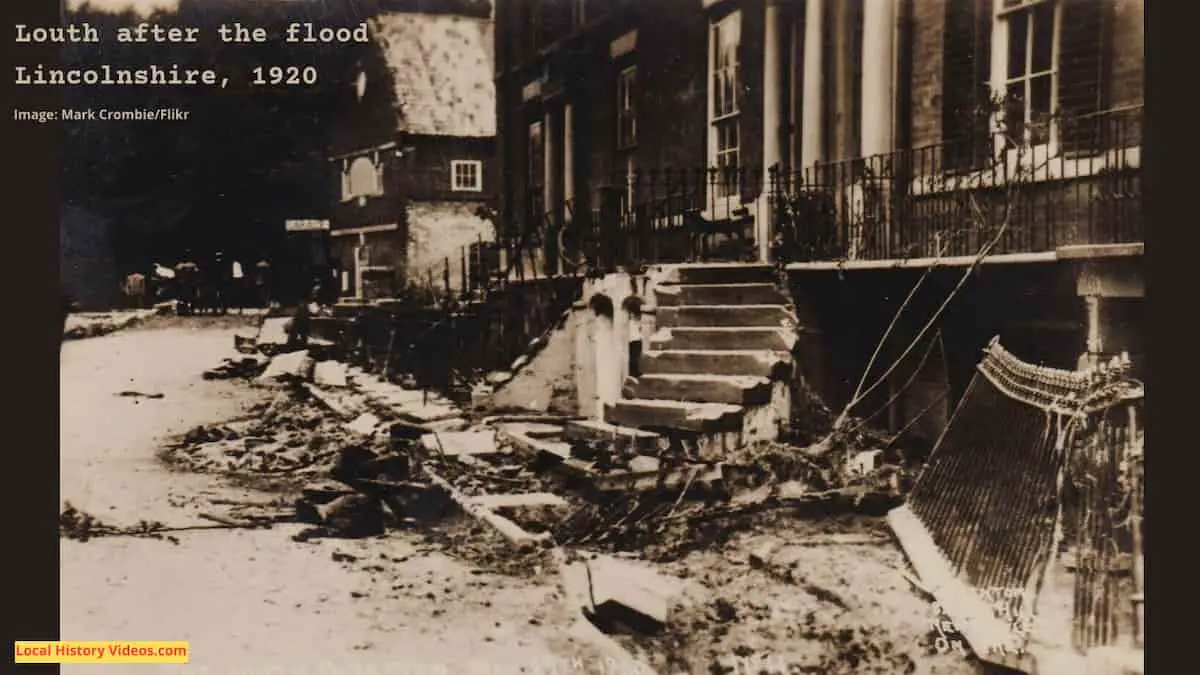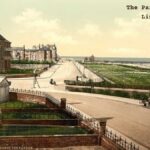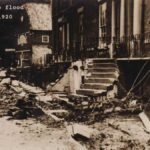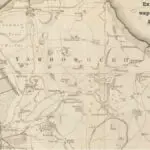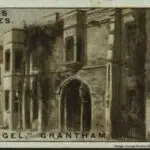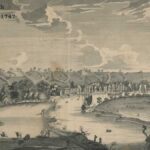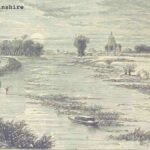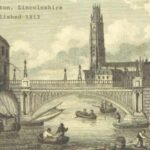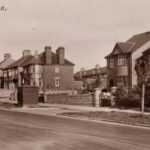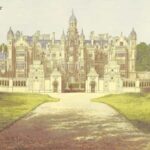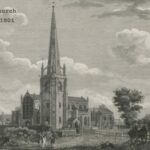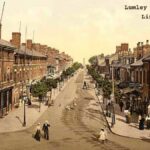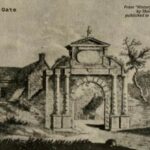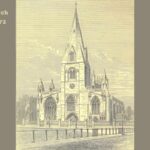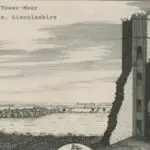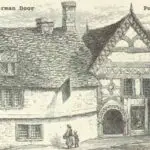Glimpse history through old images of Louth, Lincolnshire, England.
The flood of 1920 did a great deal of damage to Louth’s streets and homes. It must have been an upsetting time for residents, especially in an era of very little state support and help.
If there’s one upside, it was the arrival of the newsreel cameraman.
In just a few seconds, he shows us the damaged streets, the horse and cart collecting the belongings of evacuated residents, the vicar striding down the street, and a lady pulling up her long skirt away from the muddy street.
The ladies cleaning the wooden table, surrounded by debris, are wearing interesting hats.
Subsequent shots show so much damage it looks more like a hurricane hit the market town, than heavy rain and flooding.
As the cameraman moved position around the streets to capture the scale of damage done, he also recorded a rare series of images showing Louth’s streets, buildings and people in 1920.
The Aftermath Longer Version Of Floods (1920) – British Pathé on YouTube
A second reel shows yet more scenes of destruction, cleaning and repairing.
Floods A Shorter Version Of The Aftermath (1920) – British Pathé on YouTube
A bit of Louth history
Extract from: Post office directory of Lincolnshire, by Kelly’s directories, Ltd
Published in 1885
Pages 553 – 555
LOUTH is a municipal borough, head of a union and county court district, and polling place for the Northern division of the county, market town, railway station and parish, having separate jurisdiction, locally in the parts of Lindsey, hundred of Louth Eske, rural deanery of Louth Eske and Ludburgh No. 3, archdeaconry of Stow and diocese of Lincoln, pleasantly situated in a fertile vale, on the East Lincolnshire railway, and on the eastern side of the Wolds, 140 miles from London, 15 south from Grimsby, 26 east – north – east from Lincoln, 13 north – by – east from Horncastle, 34 east from Gainsborough, 13 north – west from Alford, and 33 north from Boston.
The ancient name of this town was Luda, which is supposed to have been derived from its vicinity to the small river Lud; it was formerly distinguished for its religious houses, and its inhabitants strongly resisted the measures enforced by Henry VIII. for their suppression, for in 1536 they took an active part in the Lincolnshire rebellion, called the ” Pilgrimage of Grace “: the King. The borough however, marched against the insurgents with a numerous army, and compelled them to disperse; and in the following year their leader, the abbot of Barlings, the Vicar of Louth, four other priests, and several laymen, were executed at Tyburn.
In 1631 Louth was visited by a destructive plague, which swept away 754 persons: the town was nearly abandoned, all trade suspended, and the markets were deserted by the country people, who pitched a temporary mart for provisions about a mile south of the town, on the road to Alford.
The town is governed by a corporation, consisting of a mayor, six aldermen and eighteen councillors, and is divided into two wards. The Corporation also acts as the Urban Sanitary Authority. has a commission of the peace. The town, which is upwards of a mile in length, is well built, the streets are paved, and lighted with gas.
The Louth Water Works Company was incorporated by Act of Parliament in the year 1871 with a capital of £ 25,000: the works were completed in the year 1873. The town is now abundantly supplied with excellent water by the above company, whose supply is drawn from a remarkably pure spring, called ” silver spring, ” situated in the valley adjoining Hubbard’s hills, from whence the water is pumped by a powerful steam engine into a reservoir near the Horncastle road.
In 1763 an Act of Parliament was obtained for cutting a
canal, called ” the Louth Navigation, ” from the town to the
Humber: this work, completed at an expense of £ 28,000,
commences at the eastern end of the town, and after a winding course joins the Humber at Tetney lock, near North
Coates: by means of this canal vessels regularly trade with
Hull and several parts of Yorkshire, and a considerable
trade is there carried on: during the last year 306 cargoes
have been delivered, including 34 cargoes of foreign corn
delivered at Louth: the tolls received in 1883-4 amounted
to £ 1,323: the canal is managed by a committee of four, ap
pointed by the commissioners.
The East Lincolnshire rail
way passes on the eastern side of the town, and a line of
railway from Louth to Lincoln was opened in 1876, and a branch from Louth to Mablethorpe, on the shore of the
German Ocean, was completed in 1877.
The parish church of St. James is a fine structure, of the
Early Decorated and Perpendicular periods, and has a
prebendal stall attached to it in Lincoln cathedral: the
original church was erected in the Transitional, period,
probably about 1170, and of this structure many fragments
were discovered during the restoration of 1868-9: it was
almost rebuilt in the thirteenth century of Yorkshire and
Ancaster stone, and is now in plan a parallelogram, consist
ing of chancel of four bays, with aisles, celerestoried nave of
nine bays, north and south porches, a vestry north of the
chancel aisle, and a lofty tower of three stages with a pierced
and panelled parapet, four large octagonal turret – pinnacles
connected by flying buttresses with the spire, and four
smaller pinnacles; the crocketed spire, to the cross by which
it is surmounted, is 147 feet in height, and the total height
from the base of the tower is 294 feet: there are 8 bells: at
the east end of the church is an exquisitely beautiful window
of seven lights, with highly finished tracery, flanked by two
niched and canopied buttresses; the chancel appears to be
nearly of the same period as the tower, but the body of the
church is of an earlier and much inferior style; the tower,
which is built within the main walls, occupies two bays of the
nave: in the vestry are two ancient chests, the latter of which
has carved portraits of Henry VII.and his Queen, Elizabeth of
York: there were formerly three chapels or chantries,
dedicated to the Virgin, St. Peter and St. John: in 1548 the
chancel roof was repaired, and in 1550 the altars were re
moved, and 705 ounces of plate sold: in 1843 the spire was
seriously injured by lightning: in June, 1844, it was agreed
to restore it, according to the plan laid down by the late
Mr. L. N. Cottingham, and it was completed in 1846, at a
cost of £ 1,746 198. 3d.: at the west end of the church is a
fine memorial, erected by public subscription, to William
Allison esq, late banker of this town, as a testimony of respect
for his high charitable and Christian virtues; it is of Caen
stone, and has a richly carved and crocketed canopy, sup
ported by light and graceful pillars, supporting four
crocketed pinnacles: the chancel and its aisles were
thoroughly restored in 1860, and the external walls repaired
by the Ecclesiastical Commissioners: the internal fittings were supplied by the parishioners, under the direction of
Mr. James Fowler, architect: the pulpit and brass lectern
are most elaborately designed and carved, the latter,
designed by Mr. J. Withers, is set with carbuncles and other
precious stones: the west and east windows were filled with
stained glass, at the cost of Cornelius Parker esq. J.P.; and
the cost of the entire restoration was over 2,000: the
church was again restored and refitted in 1868 and 1869 by
W. Fowler esq. at a cost of £ 6,347.
The register of baptisms
dates from the year 1685; marriages, 1538; burials, 1557.
The living is a rectory, with that of St. Mary annexed, tithe
rent – charge £ 48, joint gross yearly value 500, including
147 acres of glebe with residence, in the gift of the Bishop
of Lincoln and held since 1859 by the Rev. Albert Sydney
Wilde M.A. of Trinity College, Cambridge, canon ( non
residentiary ) of Lincoln Cathedral, rural dean of Louth Esk,
chaplain to the Bishop of Lincoln, and proctor for the
Diocese.
Holy Trinity ecclesiastical parish was formed out of the
mother parish in 1867. The church, rebuilt in 1866, is a
handsome and spacious edifice of stone, in the First – Pointed
style, consisting of chancel, nave of five bays, aisles and
tower: the entire cost of the building was about 3.500: in
1882 the interior of the church was decorated with texts and
devices, as a memorial by the congregation to Mrs. and Miss
Streatfeild, the mother and sister of the vicar, who had died
in the preceding year: there are sittings for 800 persons.
The register dates from the year 1841.
The living is a vicar
age, gross yearly value 300 with good residence, in the
gift of the Bishop of Lincoln, and held since 1883 by the Rev.
Henry Bertram Streatfeild M.A. of Exeter College, Oxford.
This district includes Louth Park, and had a population in
1881 of 2,016.
St. Michael’s ecclesiastical parish was formed in 1863. The
church, erected in 1863, from plans by Mr. James Fowler, of
Louth, is an edifice of hammer – dressed stone, with ashlar
dressings, lined within with parti – coloured bricks banded with
stone, in the Late First – Pointed style, and consists of a chan
cel, nave of four bays, aisles, apsidal vestry, western porch,
a gable of two bays and a bell turret with spirelet containing
bell: the communion table, rails, prayer desk and lectern
are of oak; the reredos of alabaster and marble, with a malachite cross, elaborately worked, was the gift of Mrs. Wright:
the church was built chiefly by the liberality. the Rev.
Wm. Wright, late of Brattleby, aided by local subscriptions,
and has 500 sittings.
The register dates from the year 1863.
The living is a vicarage, net yearly value 300 with
good residence, in the gift of the rector of Louth, and held
since 1874 by the Rev. Ernest Lloyd Gardner T.A.K.C.L.
This district includes the south – eastern portion of the town,
and had in 1881 a population of 2,590.
St. Mary’s Catholic Church, Upgate, was built 1833, en
larged 1845, and restored and re – decorated 1884: this
church, so far as its imperfect architecture would admit,
has been decorated in a pleasing and effective manner; on
the chancel roof, in blue panellings, are depicted in gold and
colours, emblems of the Passion and of the Holy Eucharist:
a dado in blue and red colours gives a rich appearance to the
sanctuary: a full – length painting of S. Hugh, bishop of
Lincoln, habited in pontifical vestments, is placed on the
north side of the chancel; in the body of the church a painting of the Crucifixion and a statue of our Lord, pointing to
his heart on the north and south walls are the representations of our Lord’s journey to Calvary, known as ” The
Way of The Cross, ” and above them are the Eight Beatitudes on the western walls are full – length designs of the
apostles SS. Peter and Paul.
There are several commodious chapels in the town.
The
Baptist chapel, Eastgate, will seat 400; the Baptist chapel,
Northgate, was built 1800, and will hold 500.
The Congregational chapel, in Cannon street, was built 1820, and
will seat 5oo.
The Primitive Methodist chapel is in North
gate; it was built 1826, rebuilt 1850, and will hold 900.
The United Methodist Free church, in Eastgate, was built
1854, and has seats for 1,200.
The United Methodist Free
church, in New market, built 1867, will hold 200.
The
Wesleyan chapel, in Eastgate, was built 1808, rebuilt 1835,
and will seat 1,032 worshippers.
A cemetery was formed in 1854, on the London road: it
covers about 10 acres; in the grounds are two mortuary
chapels, erected in 1855, and has recently been enlarged by
the addition of 2 acres on the south side; it is under the
control of a burial board of 9 members.
The Free Grammar school was founded and endowed by
King Edward VI. in 1551, with the property of several ancient guilds in the town, consisting of 300 acres of land, with
several messuages and tenements: the gross yearly income.
is now about 1,192, a portion of which is appropriated to
the maintenance of twelve poor women, who reside in the
almshouses connected with the charity: the new school and
houses were erected in 1869, from the designs of Mr. Fowler,
and form a handsome block of buildings of red brick, with
stone dressings, in the style of the fifteenth century: the
school was reconstituted in August, 1878, as a first grade
school, under a new scheme issued by the Charity Commissioners: it is divided into a classical and a modern
department, and offers a liberal education on the public
school system, at a moderate cost; the tuition fees ranging
from 4 to 12 yearly, according to age: the school
has twelve scholarships of the annual value of the tuition:
and three exhibitions of the annual value of £ 40 each,
tenable for three years at any university or other place of
liberal education: the school is managed by a body of eleven
governors, the chairman being the warden for the time
being.
The Town Hall and Borough Police station, situated in
Eastgate, and erected in 1854, is a large building of brick
and stucco, and contains a spacious assembly room.
A convenient Corn Exchange, with stone front, was
erected in 1853, in the Corn Market.
The Market Hall and shops form an extensive pile of build
ings, in the French Gothic style, from designs by Messrs.
Rogers and Marsden, erected in 1866-7, with a clock tower
rising to a height of more than too feet: the Market Hall is
100 feet long and 60 feet wide, and is roofed in a single span
with a semicircular arched iron trussed roof, supported
partly on the walls and partly on carved stone corbels: there
are butchers ‘ shops and a market keeper’s office on the east side, and the whole area under the hall is cellared in eight
divisions: the clock was purchased by subscription, at a
cost of about 100 guineas.
The Market days are Wednesday and Saturday; the for
mer is principally for corn, and is well attended: large sheep.
and beast markets are held every Friday during the year,
at Quarry hill.
Fairs for sheep, cattle and horses are held
on the two last days of April, and on the Fridays before the
18th of September and the 28th of October, and on the 23rd
of November: the Spring fair is held on the Friday before
the 4th Sunday in Lent.
The Petty Sessions Court House and County Constabulary
Station, which is in Eastgate, was erected in the year 1874,
on a part of the site of the old Gaol and House of Correction:
the force for the Louth division consists of one superintendent, one sergeant, and eleven constables.
The Borough Fire Brigade Station is in Enginegate; the
appliances consist of four manual engines, hose and ladder
cart and fire escape: keys are kept at the borough police
station and with the officers of the brigade.
The Mechanics ‘ Institution, in Upgate, established about
1834, has a library containing 3,500 volumes, and the read
ing – room is supplied with 30 periodicals and 27 newspapers,
including 6 daily papers; the number of members is 439.
The Conservative Club has rooms in Upgate; the Liberal
Club, in Walkergate.
The Louth General Friendly Society was established in 1814
and now ( 1834 ) consists of 182 members, who have under
their control 12,718: 16 members receive annuities, some
of them ar 1s. yearly; the society has also sick and
funeral funds.
The Hospital and Dispensary, in Crow Tree lane, originally established in 1803, was erected at a cost of about
£ 2,000, on land leased by the Louth Corporation for 500
years, and opened May 10th, 1883: the building is of white
brick with red bands, and has beds for 20 patients; the endowments amount to £ 5,250; the number of patients under
treatment during the year ending 31st May, 1884, was 596
in the dispensary and 88 in the hospital; the total expenditure for the years 1883-4 was 616 158. 3d. and the income was 693 08, 6d.
The following are the benefactions which have been left
for distribution among the poor of Louth: -In 1550, Thomas
Spencer left money to provide coals for the poor, and his
son augmented it by the gift of a house; the present income
is £ 35 yearly. In 1573. Richard Wright, in consideration of so bequeathed to the poor by Arthur Gray and
William Richardson, granted 24 acres of land to provide
them with coals; the charity has since been augmented
by some unknown donor with six cottages, and now produces a yearly income of £ 100. In 1586, Jarratt Allandale
left a rental of a to buy cloth for the poor. In 1603,
Oliver Kennithorpe left a rental of 6 138. 4d. charge on
certain In 1638, Anthony lands at Brackenborough.
Acham left a rental of 5, charged on lands at Asterby,
Stenigot and Ramby, which is now distributed in bread to
the poor.
In 1678, John Skipworth gave 6 acres of land,
now producing 20, to provide clothing for 10 poor persons.
In 1767, Ann Wadeson bequeathed 200 for the benefit of
poor housekeepers, and in 1801, Isabella Phillipson left £ 200,
the interest to be given to 20 poor women, the two together
realising 15 yearly.
In 1762, David Atkinson erected an
organ in the church, and gave £ 600 Louth Navigation
shares, to provide a salary for the organist, the income from
which in 1883 was 15.
Codd’s Charity of too in Louth
Navigation shares, the interest of which is given to the poor.
Bradley’s charity is a field at Saltfleetby, now let for 6 a
year, to be given to the poor in bread, after payment for
care of tomb in the parish church.
In 1680, about 33
acres at Winthorpe, and 12 acres at North Somercotes were
purchased with 600, left by Edward Bolle, of London,
esquire ( son of John Bolle, of Thorpe Hall ): the property
is vested in 10 trustees; the yearly income of this charity
amounts to L94: £ 50 of this is paid to the governors of the
Louth Grammar school, under the scheme of 1878, and the
remainder is distributed for the benefit of the poor of Louth.
In 1575, Richard Wryghte, of Louth, gave to the poor of
Louth, for distribution of butter and harden cloth, ” 2
tenements in Eastgate, and about 27 acres of land at
Cockerington and Howdales; the property is vested in 12
trustees, commonly called ” the Butter Feoffees “; this
charity has received the following augmentations, viz.: 3
cottages in Padehole ( one of which is now used as a ware
house ), were left by Robert Osney in 1637: the Ship inn
and 1 acre of land, left by William Wadsley, in or about
1725, and 3R. 16P, awarded at the enclosure of the open
fields In Louth, under an Act of 41 Geo. III.; in 1877,
the 2 tenements in Eastgate, and the Ship inn and r acre
of land were sold by the trustees, with consent of the Charity
Commissioners, and the purchase monies ( after payment of
expenses ), 962 8s. gd. invested in Consols. The yearly
income of Wryghte’s, Osney’s and Wadsley’s charity ( commonly called The Louth Butter Charity ” ), amounts to
101 148. 10d.; Eso of this is paid to the governors of the
Louth Grammar school, under the scheme of 1878, and the
remainder is distributed to the poor of Louth, in donations
of 48. each about Christmas, the practice of distributing
butter has been discontinued many years.
There are two branches of the Church of England Temperance Society in Louth, one in St. James ‘ parish, the
other in Holy Trinity parish. There is also a Band of Hope
Society connected with the latter. The combined member
ship of the two latter is 3oo.
The 6th Battery of the 1st Lincolnshire Volunteer Artillery
brigade is stationed here.
The D Company of the 1st Volunteer Battalion Lincoln
shire Regiment is also here.
There is a Freemasons ‘ Lodge here, which has commodious
rooms in Rosemary lane.
Louth Savings Bank, Eastgate, was established 1817; the
building was erected in 1860; it is a brick building with
stone dressings, in the Decorated Gothic style of architecture, from a design by James Fowler esq. of Louth the
cost was about 600: for the year ending November, 1883,
the total number of accounts was 2,916 and the amount of
deposits 83,167 os. 8d.
The Penny Bank, Eastgate, was
established in October, 1859: the number of accounts in
1884 was 671, and the amount of deposits 247 158. 9d.
The principal hotels are the King’s Head, Mercer row and
the Mason’s Arms, Corn market.
Here are several tanneries, iron foundries, and agricultural implement manufactories; and a trade is carried on
in brewing, malting, bone crushing, lime burning, and rope
and brick making.
The area of the parish is 3,620 acres; rateable value
£ 37.753; the population in 1881 was – of the parish 10,827,
and of the township and municipal limits, 10,691, which includes 152 officers and inmates in the workhouse.
LOUTH PARK, formerly an extra – parochial liberty, is now
included in the ecclesiastical parish of Holy Trinity, but is
not included in the municipal borough of Louth; it is half
a mile east from the town and station of Louth. An extensive abbey was founded here by Alexander, Bishop of Lincoln,
in 1139, for monks of the Cistercian order, dedicated to the
Virgin Mary: the foundation and portions of carved work,
shafts and capitals remain, as well as some of the walls in
the Transitional style: its revenue, in 1296, amounted to
246 98, 3d. and at the dissolution in 1535, to 169 58, 6d.
Abbey Park House, the property of William Allison esq. is
the residence of John Iles esq. William Allison esq. and
Thomas Beverley esq. of Ketsby, are the sole landowners.
The soil is loamy: subsoil, clay, with marl. The chief
crops are wheat, barley and oats. The area is returned
with Louth parish; rateable value, L1,282; the population
in 1881 was 136.
More about Lincolnshire
- Old Images of Lincolnshire, England
- Old Images of Louth, Lincolnshire
- Old Images of Immingham, Lincolnshire
- Old Images of Grantham, Lincolnshire
- Old Images of Gainsborough, Lincolnshire
- Old Images of Crowland, Lincolnshire
- Old Images of Boston, Lincolnshire
- Old Images of Scunthorpe, Lincolnshire
- Old Images of Harlaxton Manor, Lincolnshire
- Old Images of Spalding, Lincolnshire
- Old Images of Skegness, Lincolnshire
- Old Images of Scampton, Lincolnshire
- Old images of Cranwell, Lincolnshire
- Old Images of Sleaford, Lincolnshire
- Old Images of Horncastle, Lincolnshire
- Old Images of Stamford, Lincolnshire
- Old images of Keadby Bridge, Lincolnshire

